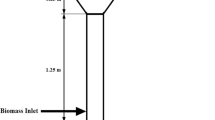Abstract
This study is aimed to discover and investigate the performance of wet natural gas dehydration process by absorption using liquid desiccant. Triethylene glycol (TEG) was used as liquid desiccant. The dehydration process includes absorption and TEG regeneration sections. The process was simulated in Aspen-Hysys environment and was technically analysed. A thorough analysis of dehydration process was performed. The effects of natural gas and solvent flowrate, overhead vapour rate, and distillation column pressure as operative parameters on the recovered TEG purity, water content of dry gas, reboiler duty, and TEG loss were assessed. Further, response surface methodology based on central composite design was used to design the experiments. In statistical approach TEG flowrate, distillation column pressure, and reboiler temperature were selected as operative parameters and reboiler duty, recovered TEG flowrate, and recovered TEG purity as responses. Analysis of variance was performed to find out the importance of each parameters. Statistical models were developed and optimization process was performed. The maximum obtainable recovered TEG purity was 0.9651 corresponded to TEG flowrate, distillation column pressure, and reboiler temperature of 2.91 kg mol/h, 40.52 kPa, and 190.97 °C, respectively.











Similar content being viewed by others
References
Darwish NA, Hilal N (2008) Sensitivity analysis and faults diagnosis using artificial neural networks in natural gas TEG-dehydration plants. Chem Eng J 137(2):189–197
Farag HAA, Ezzat MM, Amer H, Nashed AW (2011) Natural gas dehydration by desiccant materials. Alex Eng J 50(4):431–439
Gandhidasan P (2003) Parametric analysis of natural gas dehydration by a triethylene glycol solution. Energy Sources 25(3):189–201
Ghiasi MM, Bahadori A, Zendehboudi S (2014) Estimation of the water content of natural gas dried by solid calcium chloride dehydrator units. Fuel 117:33–42
Ghiasi MM, Bahadori A, Zendehboudi S, Chatzis I (2015) Rigorous models to optimise stripping gas rate in natural gas dehydration units. Fuel 140:421–428
Hashemzehi M, Pirouzfar V, Nayebzadeh H, Alihosseini A (2020) Application of response surface methodology to optimize high active Cu–Zn–Al mixed metal oxide fabricated via microwave-assisted solution combustion method. Adv Powder Technol 31(4):1470–1479
Hazrati H, Jahanbakhshi N, Rostamizadeh M (2018) Hydophilic polypropylene microporous membrane for using in a membrane bioreactor system and optimization of preparation conditions by response surface methodology. Polyolefins J 5(2):97–109
Hedayati Moghaddam A (2022) Simulation and optimization of separation section in methanol to olefin (MTO) process based on statistical approach. Chem Pap 76(8):4787–4794
Hedayati Moghaddam A, Hazrati H, Sargolzaei J, Shayegan J (2017) Assessing and simulation of membrane technology for modifying starchy wastewater treatment. Appl Water Sci 7(6):2753–2765
Isa MA, Eldemerdash U, Nasrifar K (2013) Evaluation of potassium formate as a potential modifier of TEG for high performance natural gas dehydration process. Chem Eng Res Des 91(9):1731–1738
Lin H, Thompson SM, Serbanescu-Martin A, Wijmans JG, Amo KD, Lokhandwala KA, Merkel TC (2012) Dehydration of natural gas using membranes. Part I: composite membranes. J Membr Sci 413–414:70–81
Mahmoudian F, Moghaddam AH, Davachi SM (2022) Genetic-based multi-objective optimization of alkylation process by a hybrid model of statistical and artificial intelligence approaches. Can J Chem Eng 100(1):90–102
Masoudi SMA, Hedayati Moghaddam A, Sargolzaei J, Darroudi A, Zeynali V (2018) Investigation and optimization of the SND–SBR system for organic matter and ammonium nitrogen removal using the central composite design. Environ Prog Sustain Energy 37(5):1638–1646
Moghaddam AH, Shayegan J, Sargolzaei J (2016) Investigating and modeling the cleaning-in-place process for retrieving the membrane permeate flux: case study of hydrophilic polyethersulfone (PES). J Taiwan Inst Chem Eng 62:150–157
Nemati Rouzbahani A, Bahmani M, Shariati J, Tohidian T, Rahimpour MR (2014) Simulation, optimization, and sensitivity analysis of a natural gas dehydration unit. J Nat Gas Sci Eng 21:159–169
Paymooni K, Rahimpour MR, Raeissi S, Abbasi M, Baktash MS (2011) Enhancement in triethylene glycol (TEG) purity via hydrocarbon solvent injection to a TEG+ water system in a batch distillation column. Energy Fuels 25(11):5126–5137
Rahbar A, Nekoomanesh-Haghighi M, Bahri-Laleh N, Abedini H (2015) Effect of water on the supported Ziegler–Natta catalysts: optimization of the operating conditions by response surface methodology. Catal Lett 145(5):1186–1195
Rahmanian B, Pakizeh M, Esfandyari M, Maskooki A (2011) Fuzzy inference system for modeling of zinc removal using micellar-enhanced ultrafiltration. Sep Sci Technol 46(10):1571–1581
Salman M, Zhang L, Chen J (2020) A computational simulation study for techno-economic comparison of conventional and stripping gas methods for natural gas dehydration. Chin J Chem Eng 28(9):2285–2293
Sijbesma H, Nymeijer K, van Marwijk R, Heijboer R, Potreck J, Wessling M (2008) Flue gas dehydration using polymer membranes. J Membr Sci 313(1):263–276
Vaziri H, Hedayati Moghaddam A, Mirmohammadi SA (2020) Optimization of distillation column in phenol production process for increasing the isopropyl benzene concentration using response surface methodology and radial basis function (RBF) coupled with leave-one-out validation method. Chem Pap 74(10):3311–3324
Zeynali V, Sargolzaei J, Hedayati Moghaddam A (2016) Optimization of several hydrodynamic and non-hydrodynamic operating parameters in treatment of synthetic wastewater containing wheat starch in a sequencing batch reactor (SBR) using response surface methodology. Desalin Water Treat 57(51):24240–24256
Author information
Authors and Affiliations
Corresponding author
Ethics declarations
Conflict of interest
The corresponding author states that there is no conflict of interest.
Additional information
Publisher's Note
Springer Nature remains neutral with regard to jurisdictional claims in published maps and institutional affiliations.
Rights and permissions
Springer Nature or its licensor (e.g. a society or other partner) holds exclusive rights to this article under a publishing agreement with the author(s) or other rightsholder(s); author self-archiving of the accepted manuscript version of this article is solely governed by the terms of such publishing agreement and applicable law.
About this article
Cite this article
Hedayati Moghaddam, A. Investigation of natural gas dehydration process using triethylene glycol (TEG) based on statistical approach. Chem. Pap. 77, 1433–1443 (2023). https://doi.org/10.1007/s11696-022-02564-8
Received:
Accepted:
Published:
Issue Date:
DOI: https://doi.org/10.1007/s11696-022-02564-8




